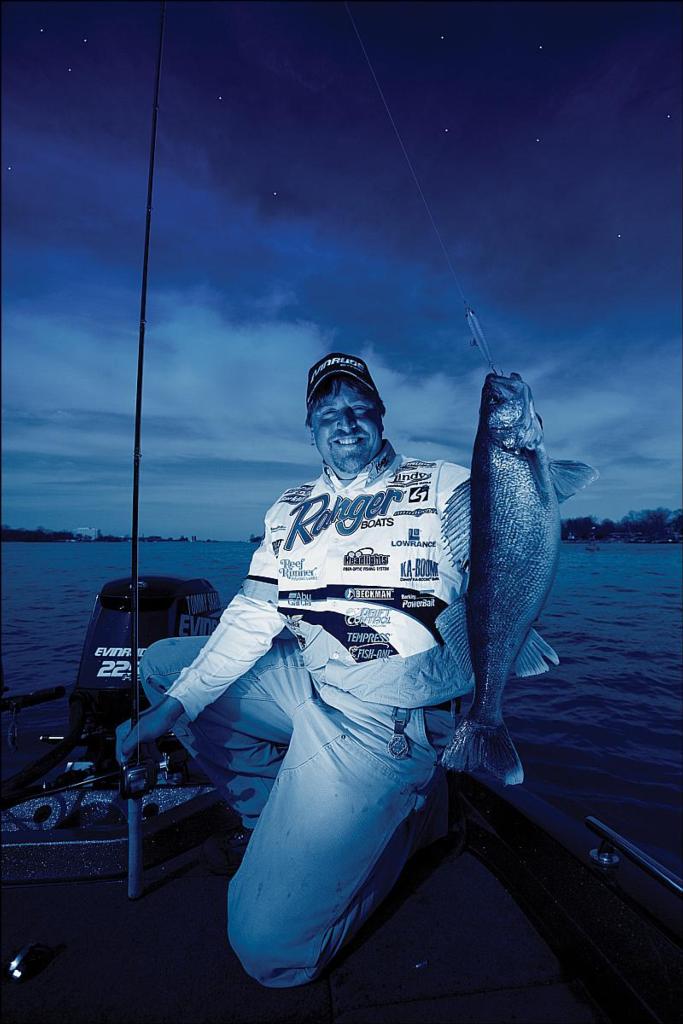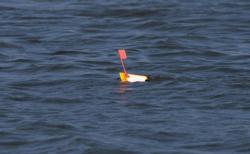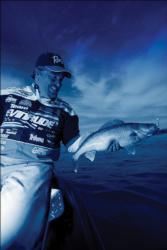Unlocking the mysteries of successful night walleye fishing
Marble ’eyes will be coming up shallow when the sun goes down

————————————–
Editor’s note: This article originally appeared in the July 2006 issue of FLW Outdoors Magazine. Learn more about FLW Outdoors Magazine and how to subscribe by clicking here.
————————————–
Is there a better place to grow up than Waterloo, Iowa? For pro Tommy Skarlis there sure wasn’t – Waterloo was the perfect setting. As a kid, he could fish walleye lakes and rivers in Iowa, Wisconsin, Minnesota or Illinois. Even better, during the sticky dog days of July, when fish sulked deep and clear summer water meant no one could dupe them, he learned to walleye fish at night.
It was at night that he cleaned up on big fish.
With their visual acuity for low-light condition feeding, and that includes through the complete darkness of night, walleyes are uniquely and perfectly equipped for efficient nocturnal predation. That means both boating and wading night-fishermen can get a great shot at big fish.
“The strategy is to catch ’em when you can catch ’em,” Skarlis said in typical Midwestern-learned wisdom. “In crystal-clear lakes and rivers in the summer when they’re dormant all day, they move up to feed at night.”
A lot has changed for Skarlis since those simple, down-home trips night-fishing on the Mississippi. He’s 40 years old now; a veteran of just about every pro-am tour there is or ever was, a successful professional angler who fished his first pro-am going back as far as 1993. He has earned the Wal-Mart FLW Walleye Tour Angler of the Year runner-up position each of the past two years.
Skarlis doesn’t fish through the night as much as he used to, particularly given so many tournament appearances that are required of him, but he still gets in plenty of staying-past-dusk fishing on his own time, and he recalled his Mississippi River night trips fondly.
“Night-fishing is a little bit of everything,” he said with enthusiasm. “But the key thing is more fish can be accessed at night.”
Skarlis points out a lot of walleye anglers like to stay out well past dark for just that reason, especially if the bite’s on, and this constitutes the simplest form of entry into night-fishing. It’s a widespread practice, too, from fishing shoals from dusk to midnight on late-summer nights on the Columbia River in the West, to fishing deep river holes in January into the wee hours of the morning on the Missouri.
Fish shallow, cover water
Skarlis’ fishing nature is that of a searcher, and for him, the best searching and covering water technique at night is trolling.
“It’s one of the best tactics,” he said. “At night, for almost all my night-fishing, I’m concentrating on fish that are up scattered on shallow flats. That means covering as much water as possible to pick them off. If they’re schooled up, you can do other tactics. But at night on shallow weed flats, walleyes are up there chasing perch, shad, minnows and other critters that they don’t get up there to chase during the day.”
 Skarlis uses planer boards when he trolls at night because boards provide distance from the boat and stealth. Even though it’s dark, stealth has to be taken to a whole new level at night because noise and commotion can be huge negative factors.
Skarlis uses planer boards when he trolls at night because boards provide distance from the boat and stealth. Even though it’s dark, stealth has to be taken to a whole new level at night because noise and commotion can be huge negative factors.
“You might think it’s easier to fish because it’s dark. But noise is a factor, and so is casting too much ambient light,” Skarlis said. He explained that if anything looks unusual or unnatural to fish at night, their reaction to it can be instantly negative – meaning you can spook these fish a lot more easily than you’d think.
“Sometimes we overthink the fish,” he said, “but for night-fishing, an ounce of prevention is worth more than a pound of cure. Remember that things are quieter and darker. You have to be careful.”
Skarlis starts out by setting up with lighted planer boards. He likes Off Shore Tackle’s new lighted boards, because instead of having to add a light, the whole flag is already lit up. Behind the boards, the veteran tournament angler pulls his nighttime favorites, which are crankbaits.
He wants his crankbaits to work the upper portion of the water column where they can be easily seen by marauding walleyes, diving no deeper than 25 percent of the total water column depth. That is, in 10 feet of water he’d like that crankbait to work down around 2.5 feet. In 5 feet of water, he wants it to only dive 1.25 feet or thereabouts. “My approach is to fish mostly 15 feet and above. It’s pretty much a mow-the-lawn, cover-the-water type of fishing,” Skarlis said.
Choosing colors
Skarlis is a big fan of match-the-hatch tactics. He thinks the bigger the profile the natural baitfish have, the better. That’s because there’s no superior way to match a profile in clear water, Skarlis believes, than to fish dark colors on dark nights up in the shallows.
“You wouldn’t think that would work,” Skarlis admitted. “But fishing something with some real profile, especially in the upper water column on really, really dark nights, that can be phenomenal.”
 That means big, dark crankbaits.
That means big, dark crankbaits.
In cloudier, murkier water, Skarlis relies, as do many walleye anglers, on lure-coat technologies. “You really want something then with some subtle glow to it,” he says. “You want colors that glow – Lindy’s Techni-Glo, for example.” For technologies that absorb light, that benefit from being hit with light before fishing them, Skarlis urges an easy touch. “The amount of charge you put on a glow lure will affect how the fish respond to it,” he said. “Don’t use too much – it can spook them. I like a subtle lantern flash, rather than a big, bright-light strobe.”
Quiet down
To the extent that a 2- or 4-stroke kicker motor makes noise, Skarlis says if the noise is constant and steady, and if you’re using boards, you’ve negated as much commotion as you can. But Skarlis has recently equipped his Ranger with a Minn Kota electric that fits on the lower unit of his main engine.
“I can steer with the big steering wheel,” he said, “or do it with the remote. It’s 101 pounds of thrust, and with the technology of today’s batteries, I can run for eight hours with it.”
That extra bit of noise reduction may only give a psychological edge, or it could really be adding enough additional stealth to put one or two (or more fish) into the boat for the evening’s work. If nothing else, it adds a touch of thoughtful quality to the already agreeable experience of being on the water and fishing at night.
Jig deep and prosper
Skarlis likes to find walleyes where he expects to find them, and preferably that’s up shallow when there’s a lot of perch around or where there are scads of shad being chased by singularly focused, oversized walleyes. But if the fish aren’t there, flexibility rules.
“If they aren’t up there,” Skarlis said, “look deeper. It’s not uncommon to fish deep for walleyes at night.”
Skarlis cut his teeth on this kind of fishing. “I’ve caught them vertical jigging in the Mississippi at night,” he said. “That’s really prevalent. Especially since the river has become clearer.”
For this kind of fishing, Skarlis again turns to profiling his bait.
“I’ll go with something with a large, bulky plastic,” he said. “You can fish smaller plastics in the spring, but your bait should be bigger later in the year. Bulk it up. I use roundhead jigs, and throw a lot of Gulp!  and Power Bait plastics, like Power Minnows. You want to give a pretty big prey profile.”
and Power Bait plastics, like Power Minnows. You want to give a pretty big prey profile.”
Hooking and fighting fish
Maybe one of the things that makes Skarlis a champion is his attitude toward that lyrical night siren, a fish hitting and the water exploding.
“I don’t give them the benefit of the doubt, especially at night,” Skarlis declared. “If they get any slack at all, they’re going to shake. You have to keep the force on them. You have to have good coordination and communication with your partner or partners in the boat, too.” Skarlis is fond of spotlights for a partner to shine on the water during the fight.
A vastly different animal
Fishing at night is an entirely different experience than fishing in the comforting light of daytime. A river at night is a vastly different animal, and so too are lakes and reservoirs where the darkness not only dictates different fishing strategies but also disallows seeing things like navigational hazards.
“Safety has to be a major concern at night,” Skarlis warned. “Don’t go out alone at night, for any reason. Always fish with someone. Light your boat properly, meaning your running lights and stern light.”
If you haven’t tried night-fishing for walleyes, don’t let it intimidate you.
“My attitude is, from an angler’s perspective, night-fishing has a mystique to it,” Skarlis said. “Even the toughest of tough guys, they’re slightly, well, it can be a little bit intimidating. But the only boogeyman out there is a big walleye, or an occasional catfish.”
Boat safely at night
Boating and fishing at night present unique challenges and warrants that all of the standard safety gear that should be on board your vessel anyway, should absolutely, positively be there, and in good working condition. This includes fire extinguishers, visual distress signals and a whistle, bell or horn. Some states require running lights to be on at all times while on the water at night, so check local boating regs before staying out after dark.
In addition, it’s important to have a reliable anchor and proper length of rope in case you lose engine power and need to anchor in a safe spot. VHF radio and cell phones come in mighty handy during emergency situations, too. Navigational aids, like compasses and GPS units, should be in top working condition.
 Boat lights are not only required by law but critical for other vessels to see you. That includes green/red bow lights and a white stern light. It’s a good idea to carry spare fuses and bulbs on board – bow light bulbs, especially, are notorious for going out. Flashlights, headlamps, lanterns and spotlights (along with extra batteries) are a must.
Boat lights are not only required by law but critical for other vessels to see you. That includes green/red bow lights and a white stern light. It’s a good idea to carry spare fuses and bulbs on board – bow light bulbs, especially, are notorious for going out. Flashlights, headlamps, lanterns and spotlights (along with extra batteries) are a must.
If you make night-fishing a habit, consider buying fishing rods that have glo-tips that can be seen at night or painting tips with fluorescent paint. Mounting lights inside hatches and lockers, even temporary ones, will save you untold frustration when it comes to stowing and retrieving gear. Pretie all your tackle beforehand, with plenty of extra rigs, so you don’t have to fumble with them in the dark with mosquitoes buzzing around your head.
For low visual impact, set your boat up with internal red lights. More than a few anglers also use high-visibility fluorescent fishing line at night, with black lights pointed outward on their boats, which aids in seeing lines as well as structure. Lighted floats and lighted planer boards are a big help, too.
Lastly, pay attention to weather. Being out at night and in a storm at the same time is not good. Conversely, track moon phases carefully for those beautiful, clear nights on either side of the full moon, which are great walleye feeding nights.